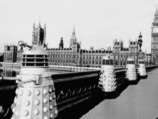 |
|
Daleks in London
|
|
 Radiation nil, oxygen normal, pressure normal...an earth reading! The TARDIS has landed in London. A menacing deserted London, with no sign of life and no sense of normality, but the decaying city is not as empty as it seems. The year is 2164 and the travellers soon find themselves facing antagonists whom they thought they had destroyed . .. the Daleks. They have conquered the earth. Radiation nil, oxygen normal, pressure normal...an earth reading! The TARDIS has landed in London. A menacing deserted London, with no sign of life and no sense of normality, but the decaying city is not as empty as it seems. The year is 2164 and the travellers soon find themselves facing antagonists whom they thought they had destroyed . .. the Daleks. They have conquered the earth.
 Ten years after a cosmic storm continents of people were wiped out by a plague. Then the Daleks came in saucers, shipping humans to vast mining areas, turning them into Robomen and against their fellow humans. Earth contains something no other planet contains – a magnetic core - but why are the Daleks digging for it and how can The Doctor prevent them from tampering with the forces of creation? Ten years after a cosmic storm continents of people were wiped out by a plague. Then the Daleks came in saucers, shipping humans to vast mining areas, turning them into Robomen and against their fellow humans. Earth contains something no other planet contains – a magnetic core - but why are the Daleks digging for it and how can The Doctor prevent them from tampering with the forces of creation?
|
| | Source: BBC VHS Video | |
| Season: |
Two
|
| Production
Code: |
K |
| Story Number: |
10
|
| Episode Numbers: | 46 - 51 |
| Number of
Episodes: |
6 | | Percentage of Episodes Held: | 100% | | Alternative Titles: | "The Invaders" and "World's End" | | Working Titles: | "The Return of the Daleks" |
| Production
Dates: |
August - October 1964 |
| Broadcast Started: | 21 November 1964 | | Broadcast Finished: | 26 December 1964 |
| Colour Status: |
B&W |
|
Studio: |
Riverside (Studio 1) |
|
Location: |
London: Whitehall, Trafalgar Square, Westminster Bridge, Albert Embankment, The Royal Albert Hall, Kensington, the Albert Memorial, Wembley, Wood Lane (Central Line) tube station, St Katherine's Dock (Wapping) and Kew railway bridge.
Others: John’s Hole Quarry. |
|
| Writer: | Terry Nation | | Director: | Richard Martin | | Producer: | Verity Lambert | | Associate Producer: | Mervyn Pinfield | | Story Editor: | David Whitaker | | Editor: | John Griffiths | | Production Assistant: | Jane Shirley | | Assistant Floor Manager: | Christina Lawton | | Designer: | Spencer Chapman | | Costume Designers: | Tony Pearce and Daphne Dare (Episodes 1, 2, 5 & 6) | | Make-Up Designers: | Elizabeth Blattner (Episode 4) and Sonia Markham (Episodes 1-3, 5 & 6) | | Cameraman: | Peter Hamilton | | Lighting: | Howard King | | Incidental Music: | Francis Chagrin | | Special Sounds (SFX Editor): | Brian Hodgson | | Studio Sounds: | Jack Brummitt | | Title Sequence: | Bernard Lodge | | Title Music: | Ron Grainer and the BBC Radiophonic Workshop. Arranged by Delia Derbyshire | | Daleks Originally Created By: | Terry Nation |
| Number of
Doctors: |
1 | | The Doctor: |
|
| Number of
Companions: |
3 | | The Companions: |
|
| Additional Cast: |
|
Bernard Kay (Carl Tyler), Peter Fraser (David Campbell), Alan Judd (Dortmun), Martyn Huntley, Peter Badger (Robomen), Robert Jewell, Gerald Taylor, Nick Evans, Kevin Manser, Peter Murphy (Daleks), Robert Aldous (Insurgent), Peter Hawkins, David Graham (Dalek Voices), Ann Davies (Jenny), Michael Goldie (Craddock), Michael Davis (Thomson), Richard McNeff (Baker), Graham Rigby (Larry Madison), Nicholas Smith (Wells), Nick Evans (Slyther), Patrick O'Connell (Ashton), Jean Conroy (Women in the wood), Meriel Hobson (Women in the wood) |
| | Setting: |
|
|
Villain: | Daleks
|
| No. |
Episodes |
Broadcast
(UK) |
Duration |
Viewers
(Millions) |
In
Archive |
| 46 | World's End | 21 November 1964 | 23'42" | 11.4 | 16mm telerecording | | 47 | The Daleks | 28 November 1964 | 24'19" | 12.4 | 16mm telerecording | | 48 | Day of Reckoning | 05 December 1964 | 26'50" | 11.9 | 16mm telerecording | | 49 | The End of Tomorrow | 12 December 1964 | 23'23" | 11.9 | 16mm telerecording | | 50 | The Waking Ally | 19 December 1964 | 24'29" | 11.4 | 16mm telerecording | | 51 | Flashpoint | 26 December 1964 | 25'21" | 12.4 | 16mm telerecording |
| Total Duration |
2 Hours 28 Minutes |
| Average Viewers
(Millions) |
11.9 |
| Doctor Who Magazine Poll (1998) | 75.03%  (Position = 39 out of 159) (Position = 39 out of 159) | | Doctor Who Magazine Poll (2009) | 79.21%  (Position = 44 out of 200) (Position = 44 out of 200) | | Doctor Who Magazine Poll (2014) | 80.22%  (Position = 47 out of 241) (Position = 47 out of 241) | | Doctor Who Magazine Poll (2023) | Position = 1 out of 29 |
 All episodes exist as 16mm telerecordings. An Arabic print is also held of "World's End," "The Daleks," "The End of Tomorrow" and "Flashpoint". All episodes exist as 16mm telerecordings. An Arabic print is also held of "World's End," "The Daleks," "The End of Tomorrow" and "Flashpoint". |
|
|
|
|